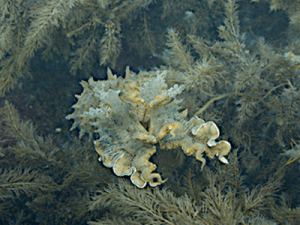Oct 13 2017
For the cuttlefish and octopus, rapidly changing their skin pattern and color to vanish into the environment is simply a part of their camouflage ability. These animals can also quickly and reversibly alter their skin into a textured, 3D surface, giving the animal a raggedy outline that resembles coral, seaweed or other objects it detects and uses for camouflage.
 Sepia apama (giant Australian cuttlefish) expressing its papillae for camouflage purposes. Credit: Roger Hanlon
Sepia apama (giant Australian cuttlefish) expressing its papillae for camouflage purposes. Credit: Roger Hanlon
Recently, Engineers at Cornell University revealed their invention of stretchable surfaces with programmable 3D texture morphing, an artificial “camouflaging skin” inspired by examining and modeling the real thing in octopus and cuttlefish. The team, along with collaborator and Cephalopod Biologist Roger Hanlon from the Marine Biological Laboratory (MBL), Woods Hole, report on their controllable soft actuator in the Science (October 13th issue).
Headed by James Pikul and Rob Shepherd, the team’s pneumatically stimulated material takes a cue from the 3D bumps, or papillae, that cephalopods can exhibit in one-fifth of a second for camouflage and then retract to swim away with least hydrodynamic drag.
Lots of animals have papillae, but they can’t extend and retract them instantaneously as octopus and cuttlefish do. These are soft-bodied molluscs without a shell; their primary defense is their morphing skin.
Roger Hanlon, Cephalopod Biologist, the Marine Biological Laboratory (MBL)
Papillae are examples of a muscular hydrostat, biological structures comprising muscle without skeletal support (for example the human tongue). Hanlon and members of his laboratory, including Justine Allen, currently at Brown University, were the first to illustrate the structure, function and biomechanics of these transforming 3D papillae in detail.
“The development of this material is an excellent example of the applications that can derive from studying the fundamental biology of marine organisms,” says MBL Director of Research David Mark Welch.
The degrees of freedom in the papillae system are really beautiful. In the European cuttlefish, at least nine sets of papillae are independently controlled by the brain. And each papilla goes from a flat, 2D surface through a continuum of shapes until it reaches its final shape, which can be conical or one of a dozen possible shapes. It depends on how the muscles in the hydrostat are arranged.
Roger Hanlon, Cephalopod Biologist, the Marine Biological Laboratory (MBL)
“Engineers have developed a lot of sophisticated ways to control the shape of soft, stretchable materials, but we wanted to do it in a simple way that was fast, strong and easy to control,” says Lead Author James Pikul, currently an Assistant Professor in the Department of Mechanical Engineering and Applied Mechanics at the University of Pennsylvania. “We were drawn by how successful cephalopods are at changing their skin texture, so we studied and drew inspiration from the muscles that allow cephalopods to control their texture, and implemented these ideas into a method for controlling the shape of soft, stretchable materials.”
“This is a classic example of bio-inspired engineering” with a variety of potential applications, Hanlon says. For instance, the material could be controllably transformed to reflect light in its 2D spaces and absorb light in its 3D shapes. “That would have applications in any situation where you want to manipulate the temperature of a material,” he says.
Cuttlefish and octopus only exhibit papillae for camouflage purposes, Hanlon says, and not for locomotion, aggression or sexual signaling. “
For fast swimming, the animal would benefit from smooth skin. For sexual signaling, it wouldn’t want to look like a big old wart; it wants to look attractive, like a cool-looking mate. Or if it wanted to conduct a fight, the papillae would not be a good visual to put into the fight. Signaling, by definition, has to be highly conspicuous, unambiguous signals. The papillae would only make it the opposite!
Roger Hanlon, Cephalopod Biologist, the Marine Biological Laboratory (MBL)
Skin Close-ups of a Live Octopus rubescens Expressing its Skin Papillae
Citation:
J.H. Pikul, S. Li, H. Bai, R.T. Hanlon, I. Cohen and R.F. Shepherd (2017) Stretchable surfaces with programmable 3D texture morphing for synthetic camouflage skins. Science DOI: 10.1126/science.aan5627
References:
Allen JJ, Bell GRR, Kuzirian AM, Hanlon RT (2013). Cuttlefish skin papilla morphology suggests a muscular hydrostatic function for rapid changeability. J. Morphology 274: 645-656.
Allen JJ, Bell GRR, Kuzirian AM, Velankar SS, Hanlon RT (2014). Comparative morphology of changeable skin papillae in octopus and cuttlefish. J. Morphology 275: 371-390.
Panetta, D., Buresch, K., Hanlon, R.T. (2017). Dynamic masquerade with morphing 3D skin in cuttlefish. Biology Letters 13, 20170070 (featured in Nature Vol 544 Research Highlights).